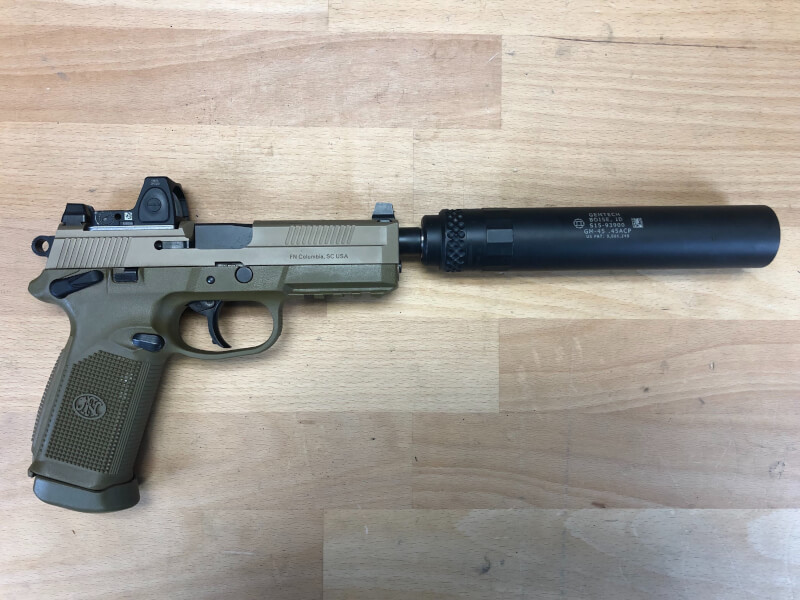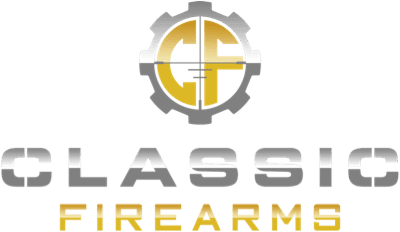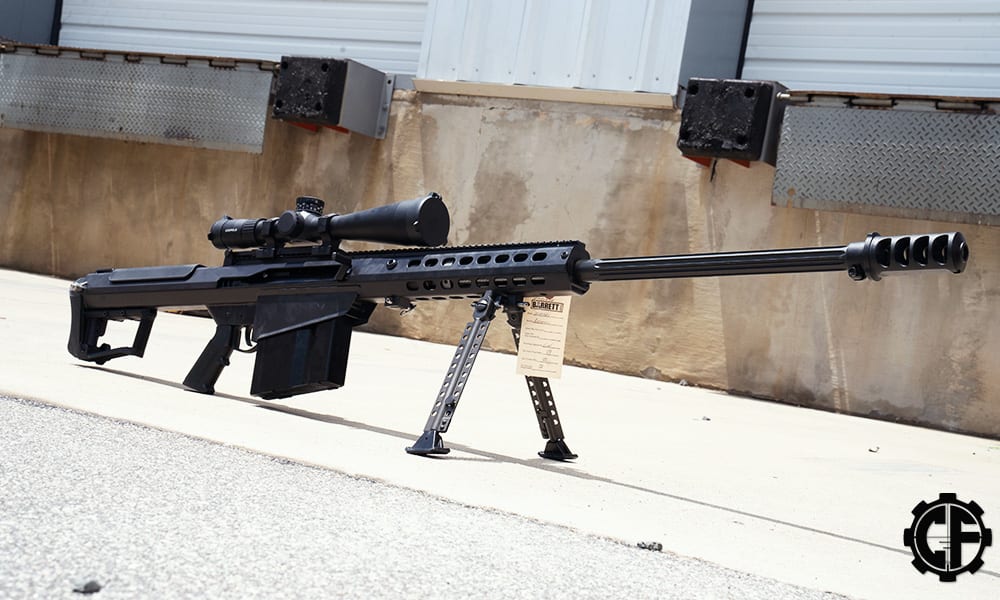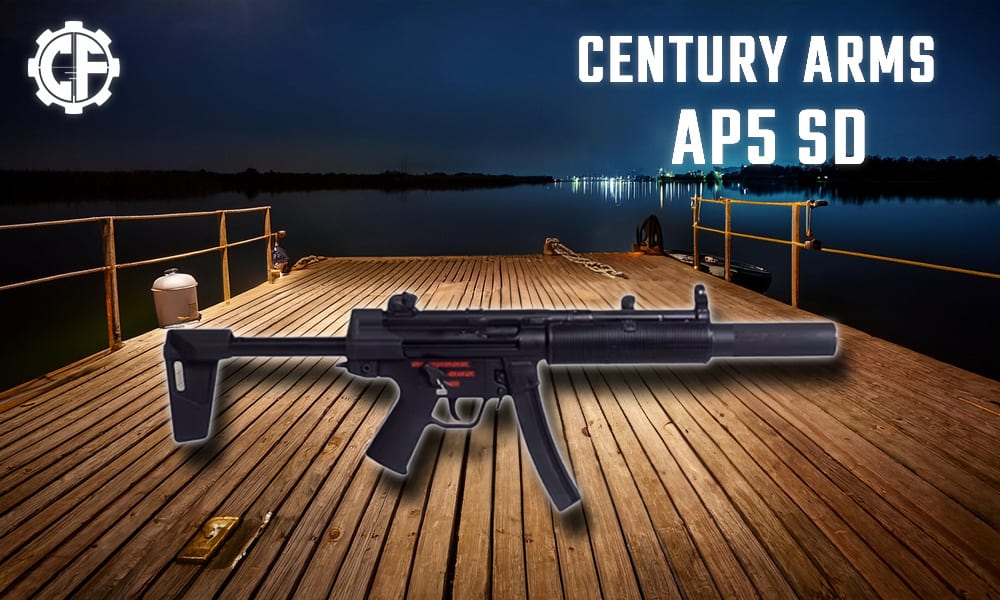Firearms are loud; we all know this. What if there was a way to tame all of that noise? Just like the muffler on your car keeps it from being overly loud, suppressors lower the sound signature of firearms. Suppressors are firearms accessories that provide options for more comfortable shooting and ultimately make the firearms lifestyle more enjoyable. What are Suppressors? A suppressor is any firearm device, accessory, or part that lowers the decibel (noise) level of a fired shot. Suppressors are usually removable, giving folks the option to use their firearm with it attached or not. This removable feature is important because just like firearms themselves, suppressors need periodic cleaning and maintenance. Suppressors come in all shapes, sizes, types, and calibers. 
FNX 45 pistol with Gemtech GM-45 suppressor.
Who Invented Suppressors? Around the turn of the 20th century, Hiram Percy Maxim started tinkering with the idea of a gadget that could lower the sound levels of firearm shots. If the name Maxim sounds familiar, it should, because Hiram Percy is the son of Hiram Maxim of Maxim machine gun fame. Working on and with firearms was in Hiram Percy's blood and around 1909, he patented his first suppressor design. While we call them suppressors today, Hiram Percy Maxim named his device the Maxim Silencer. Maxim's suppressor quickly became popular with target shooters, hunters, and anyone that appreciated a quieter shooting experience. How Do Suppressors Work? Suppressors function by slowing hot gasses from the fired round enabling them to expand before they exit the suppressor. As the hot gasses behind the bullet expand into the suppressor, they hit obstructions, called baffle cores, inside the suppressor. The slowing of gas exiting the suppressor muffles the concussion of the gunshot, which lowers the sound level. 
PTR91 rifle with Yankee Hill Phantom .30 Suppressor.
How are Suppressors Constructed? Suppressors typically feature a cylindrical outer container (or less commonly, a rectangular-shaped box). The internal baffle core used to slow down expanding gases fall into two configuration types: monolithic baffle cores and stacked baffle cores.
- Monolithic Baffle Core: The most modern and high-end type of baffle core is the monolithic type. These cores start as a single piece of metal and through a machining process chambers are created leaving a central hole for the bullet to pass through. Monolithic baffle cores feature a complex and highly-engineered design to optimize the slowing and expansion of gas. Since a monolithic baffle core is one piece, it is easier to remove for cleaning and maintenance.
 Gemtech GM-45 showing monolithic baffle core.
Gemtech GM-45 showing monolithic baffle core.
- Stacked Baffle Core: Unlike a monolithic baffle core, a stacked baffle core is made up of many pieces. This older suppressor design stacks multiple hollow, conically-shaped metal baffles on top of each other to slow gas down and allow it to expand. Stacked baffle core suppressors are often less expensive since the small baffle pieces are more economical to manufacture. These suppressors are slightly less convenient to maintain since they have multiple baffles to keep up with and try not to lose.
Regardless of whether suppressors use a monolithic baffle core or stacked baffle core, suppressor designs also fall into sealed and unsealed categories:
- Sealed Suppressors: Sealed suppressors are welded tubes that cannot be taken apart for maintenance. Older or more economical suppressors often feature a sealed design because they are less expensive to produce since they are just one piece. As one uses a suppressor, the baffle core becomes fouled with carbon, lead, and copper deposits. Typically, sealed suppressors require an ultrasonic tank washer to clean them, which can be problematic as those aren't the easiest to come by; however, the lower purchasing cost can make up for this expense. Some manufacturers also clean their sealed suppressors for a nominal fee.
- Unsealed Suppressors: Higher-end suppressors usually unscrew, separating the outer casing and internal baffle core. The ability to take apart a suppressor is highly desirable because the user can service the suppressor themselves to remove deposits from shooting. Unsealed suppressors are more expensive since their construction uses multiple intricate parts that must be threaded together for use; however, they do not require an ultrasonic tank washer for cleaning.
Do All Suppressors Work for All Calibers? While the internal diameter of the baffle core must be big enough for bullets to pass through and not strike them, manufacturers rate and label their suppressors for what calibers they can safely use. For instance, some suppressors accept centerfire calibers up to a specific caliber size. Other manufacturers might rate their suppressors for usable with only rimfire ammunition. Another suppressor rating is for fully automatic fire use. Higher-end suppressors usually give an increased performance from caliber flexibility and a noise reduction standpoint. At the end of the day, always consult manufacturers to see what calibers work with their suppressors or if you have questions about their ratings/capabilities. 
Daniel Defense MK18 SBR with Yankee Hill Phantom .30 Suppressor.
How do Suppressors Attach to Firearms? Other than specialty firearms that feature permanently attached suppressors, most suppressors are removable. For attachment methods, suppressors fall into two categories, direct thread and quick detach (QD).
- Direct Thread: Older types and less expensive suppressors typically use the direct thread attachment method. Direct thread suppressors attach directly to the end of a threaded barrel. These types of suppressors do not lock onto the barrel but rely on friction from tightening the suppressor by hand. Direct thread suppressors can loosen after firing so one must take care to ensure they stay tight while firing.
 The Gemtech GM-45 pistol suppressor on top features direct thread. The Yankee Hill Machine Titanium Phantom .30 suppressor below is quick detached.
The Gemtech GM-45 pistol suppressor on top features direct thread. The Yankee Hill Machine Titanium Phantom .30 suppressor below is quick detached.
- Quick Detach (QD): QD suppressors can be quickly removed and usually feature a spring-loaded latch or ratcheting lock system. The earliest kinds of QD suppressors attached to AR15 A2 birdcage flash hiders. Eventually, suppressor manufacturers began making proprietary muzzle devices (muzzle brakes and flash hiders) to attach their suppressors to firearms.
 Quick detach suppressor with compatible muzzle device.
Quick detach suppressor with compatible muzzle device.
Conclusion Suppressors make shooting more fun since they take away most of the concussive blast and noise of gunshots. Suppressors are one of the most practical accessories that one can add to a firearm and folks around you will appreciate how quiet you've made your favorite hobby.








